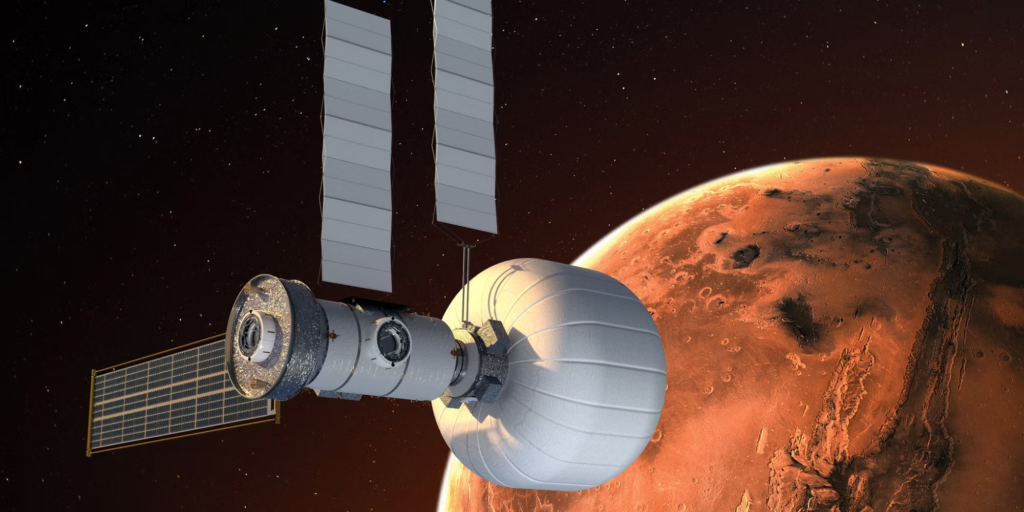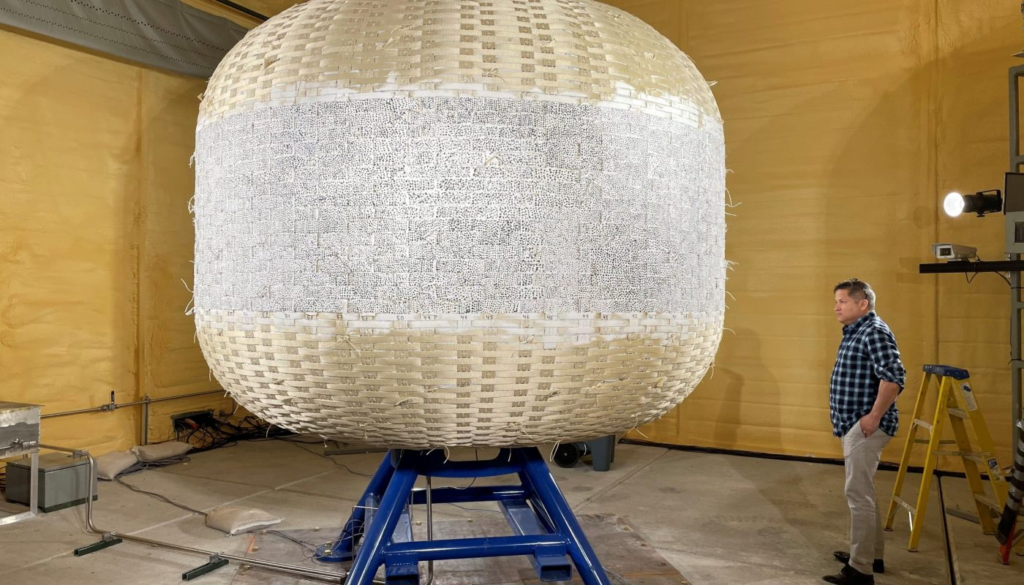
Are Inflatable Space Habitats Safe?
Companies like Sierra Space are getting close to full-scale inflatable space habitat tests in space. These rapid developments however bring up questions regarding this technology’s safety and future application. The main benefit of inflatable habitats is the ability to launch a relatively small uninflated structure which later inflates on orbit to a massive station that would not have been possible to launch at that final size.
At the same time, this restricts the company from using certain rigid materials that are more common in space station construction. Instead, they use a long list of fabrics and layers with the intention of creating a strong and safe solution. Here I will go more in-depth into the build of these habitats, the concern of micrometeoroids and other space debris, the upcoming testing schedule, and more.
Are Inflatable Habitats Safe?

Earlier this year, a company named Sierra Space completed its largest milestone yet with its LIFE Habitat. LIFE stands for Large Integrated Flexible Environment. This massive structure when fully inflated is three stories tall, measuring 27 feet (8.2m) in diameter, with an internal volume of 285 cubic meters. To put that in perspective, the International Space Station which took around a decade to construct utilizing over 30 missions, has an internal volume of 900 cubic meters. In other words, this one habitat could launch a single mission and make-up close to a third of the internal space of the ISS.
In terms of the recent milestone, they completed what they call an Ultimate Burst Pressure test (UBP), with a full-scale test article. Here, they simply pressurize the habitat and continually up the pressure until it bursts. The purpose is to measure its strength and determine how much pressure it can take before it finally explodes. The test was completed in partnership with NASA which requires a 4x safety factor. Normally, the maximum operating pressure of LIFE is 15.2 psi. For the test, NASA wanted to see it reach 60.8 psi, which is the normal pressure times 4. During the test, the full-scale unit reached 77 psi before it burst, exceeding NASA’s recommended level by around 27%. This was a very promising result and proved to NASA that the habitat was plenty strong relative to internal pressure and general strength.
This being said, the next frequent question has to do with space debris and the threat of possible micrometeoroid impacts. Sierra Space has been quoted saying that the combinations of the habitat layers “creates a structure strong enough to withstand micrometeoroid impacts and other projectiles.” In total, there are 9 layers. Starting from the inside and going out you have the air barrier, restraint layer, rear wall, 4 MMOD layers, thermal insulation, and a final layer they call the outer layer atomic oxygen. MMOD stands for Micrometeroid Orbital Debris, meaning a majority of the layers are built specifically for the purpose of helping protect the habitat from projectiles. If that wasn’t enough, the restraint layer toward the inside is constructed of high-strength “softgoods” materials, which are sewn and woven fabrics – primarily Vectran – that become rigid structures when pressurized. They point out that under normal operating pressure, the Vectran softgoods materials become 5x stronger than steel, exceeding station lifetime performance safety factors.
Importantly, there is still a decent amount of testing that needs to be completed. After the recent UBP test, the company said in a statement, “Building upon this successful test, Sierra Space will embark on an aggressive 2024 testing campaign at both sub- and full-scale, including a series of UBP tests in tandem with early-stage development of the primary Atmospheric Barrier and Micrometeoroid Orbital Debris (MMOD) layers.” This quote suggests they will soon be putting their claims to the test related to orbital debris. Assuming these tests provide good data, we could see these habitats in orbit not too long from now.
Interestingly, the large habitat they are currently working on is the smallest of a future designs. Looking at their website, they showoff plans for a LIFE 1.0, 1.X, 2.0, and 3.0, featuring a diameter of 19 meters and a staggering internal volume of nearly 5400 cubic meters. A single habitat around 6 times the size of the ISS. If successful, this could become the future of space stations and space habitats in general. This technology could also be applied to shelter on other planets and orbits. However, before then, they still have a lot of work left.
It’s Already Been Done

While Sierra Space is creating a very ambitious and modern inflatable habitat, this technology has actually already been used in space, and is even apart of the ISS. Bigelow Aerospace for example created an experimental expandable space station module. That arrived at the ISS in April 2016. It was originally planned to be a two-year test, however, it exceeded expectations and was used as additional cargo storage. The module is now under ownership of NASA after Bigelow Aerospace suspended operations in 2021.
Even though it worked better than expected, it wasn’t without some complications. The first attempt at module inflation took place in May 2016, and was suspended after higher-than-expected air pressure inside was detected with minimal expansion of the module. The attempt was terminated after two hours. They thought that the failure to expand and unfold may have been the result of the unanticipated 10-month delay in module inflation, which may have caused the fabric layers to stick together. The module was expanded later that month over the course of seven hours, with air being injected 25 times for a total of 2 minutes 27 seconds. Its length was extended 170 cm (67 in) from its stowed configuration, 2.5 cm (0.98 in) less than expected. After expansion was complete, air tanks aboard were opened to equalize air pressure in the module with that of the ISS. Finally, it was deemed safe and opened to the rest of the station.
Similar to LIFE, this test habitat consisted of multiple layers of soft fabric with spacing between layers, protecting an internal restraint and bladder system. During its time on orbit, it did experience a few space debris impacts. For example, NASA noted in May 2017 that, after spending one year in space, instrumentation had recorded “a few probable micrometeoroid debris impacts” but that the module’s protective layers had resisted penetration. Early results from monitors inside the module have shown that galactic cosmic radiation levels were also comparable to those in the rest of the space station.
This data combined with current testing has given Sierra Space confidence in this specific approach to inflatable habitats. If successful, these massive structures could become a common sight in low Earth orbit. They point out that the first product in the roadmap, LIFE 1.0, is a large, three-story structure. It can comfortably sleep four astronauts, with additional room for science experiments, exercise equipment, a medical center and Astro Garden system, which can grow fresh produce for astronauts on long-duration space missions.
In terms of specific uses, they see a big commercial application. They believe one of the most remarkable features of the LIFE habitat is its adaptability to accommodate a range of businesses, from in-space semiconductor manufacturing to pharmaceutical microgravity research. The habitat is trying to leverage the unique conditions of zero gravity, offering an optimal environment for experiments and processes that benefit from this distinct microgravity setting. In theory, with substantial volume, power, and data capabilities, the habitat is primed for extended human habitation, both for low-Earth Orbit (LEO) missions and for the demanding challenges of long-duration voyages, such as Lunar and Mars surface habitation.
They were quoted saying, “Sierra Space’s LIFE habitat products will mark a paradigm shift in space habitation, enabling a range of industries to capitalize on the advantages of zero gravity. Future developments for LIFE 2.0 and LIFE 3.0 will see increased capabilities, efficiencies, connectivity, and sustainability. As the habitat’s capabilities expand, its role in shaping the future of commercial space exploration becomes ever more pronounced, promising to open doors to uncharted realms of possibility” they said.
Besides the most recent UBP test that I mentioned prior, they have also completed a long list of experiments. Early last year for example, they successfully completed a third stress test – specifically designed for duration – exceeding NASA certification requirements and demonstrating the inflatable structure’s integrity for sustaining human life in space for long periods of time. This test, called an Accelerated Systematic Creep Test, is a destructive materials testing method by which test engineers load the test unit – a subscale version of the inflatable habitat – with a sustained amount of pressure over time until it fails. The unit’s “softgoods” pressure shell burst after over 150 hours, exceeding NASA’s short-term, recommended creep duration target of 100 hours. A good sign for the future of this technology.
Conclusion
Sierra Space is hard at work testing the LIFE habitat which inflates on orbit helping large structures fit within rocket fairings. They recently completed a full-scale burst test and have busy plans for the rest of this year. We will have to wait and see how it progresses and the impact it has on the space industry.
